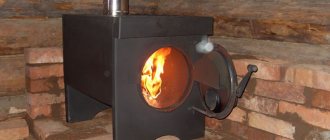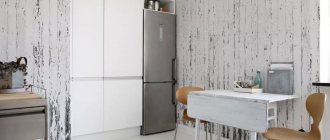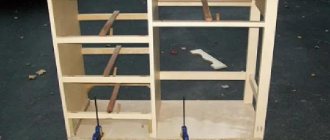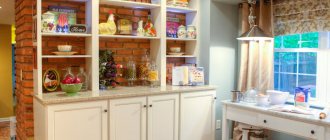The manifestation of their own individuality is characteristic of all people, and they try to do this in everything, including in the design of their homes. Everyone wants their interior design to reflect their character, hobbies, and attitude to life - hence the different choice of style, color and other solutions, the search for their own “zest.”
White brick wall in the interior
It could be a white brick wall in the interior of one of the rooms. The technique is quite common, but not hackneyed. In addition, it can emphasize the originality of any room, from the living room to the bathroom.
White brick in the interior
Brick is one of the very first construction and finishing materials used by man. And it, like wood, stone and metal, will never lose its relevance and will never go out of fashion. On the contrary, it will attract attention against the backdrop of modern materials, evoke a desire to touch and rest your eyes.
Recommendations for using brickwork in the interior
A brick wall can look very different: it can be neat and smooth, with even seams and a uniform surface, or it can be deliberately careless and rough, with gouges, scratches and remnants of plaster. It all depends on the chosen style and method of creating such a wall. Therefore, the entire surrounding environment must correspond to it, otherwise the brick will look alien and create the impression of disrepair and constant repairs.
Interior designers advise not to get carried away with this technique and listen to the following recommendations before making a brick wall:
- If your goal is not to create a bright loft interior or imitate the hall of an ancient castle, then you should not decorate all the walls in this way. It is enough to decorate only one of them or even part of it as a brick, thereby creating an accent that attracts attention;
Brick in such quantity creates a depressing impression Source domoholic.ru
- brick of a natural shade absorbs a lot of light, this must be taken into account when decorating small and poorly lit rooms;
- This finish goes with smooth painted walls, textured decorative plaster, and wood. Bad – with ceramic tiles, artificial stone, plastic panels;
- masonry itself is a striking design element , so you should not load such a wall with paintings, posters or framed photographs. An exception is made only for light, plain surfaces. The same applies to the filling of racks and shelves on a brick wall: it should be uniform in texture and color;
A wall overloaded with decor quickly tires the eye Source trastroom.ru
- if such a wall turns out to be too oppressive and cumbersome, you can hang mirrors , which will reflect calmer opposite surfaces.
See also: Catalog of companies that specialize in finishing materials.
How and what to paint
Recently, a white brick wall has become fashionable. If you are going to do just this, there are no problems: apply the seams with a brush, use a roller to apply the surface. If you want something that is not too monochromatic, add a little tint to the base color composition - gray, brown, yellow... or even pink or blue. Paint with this paint. Add more white to the remainder and add highlights with this lighter composition using a semi-dry roller, sponge, or brush. If desired, you can apply the top “shadows” with silver, bronze, adding a little gold. Here's how you like it best.
Imitation brick in the bedroom - looks very stylish
If the seams in the imitation brickwork should be darker, go over them first with a brush. Then, using a roller with short or medium pile, we paint the very surface of the bricks. If you take a roller with even shorter pile, dip it in paint of a different shade (lighter or darker - it depends), in bronze, silver, gold, etc. and with this roller, quickly, lightly touching, paint over the most protruding parts, you will get an even more interesting effect. In general, you can experiment. With this approach, imitation brick becomes a design object and the main interior decoration.
Methods for creating brick walls
Brickwork can be real or imitation, created from other materials. Moreover, there are many ways to make a brick wall with your own hands, and their choice depends both on financial capabilities and on the initial state of the surface to be finished and the desire or reluctance of the owners to get involved in dirty and labor-intensive work.
Thanks to the many options for solving this problem, it is feasible even with a modest budget and minimal experience in the field of repairs.
Method 1 - construction of brickwork
This method is ideal for those who are just building a house or have not yet started finishing. It is enough to leave one wall unplastered or build a brick partition, choosing the appropriate type: white silicate, red ceramic or colored hyper-pressed. Whether it will be a clumsy ordinary brick or a smooth facing brick depends on the idea of the future interior.
Brick is very diverse in composition, texture and color Source wixstatic.com
In an already inhabited house, this option is also possible, provided that the ceiling can support the weight of the masonry, and the area of the room will not be greatly affected by its volume. It has its advantages: it improves heat and sound insulation due to a duplicate wall.
Method 2 - opening the masonry
If the walls in the house are brick, and there is little money for repairs, you can simply remove the decorative coating from them and clean the plaster. This will save you from unnecessary expenses and thoughts about how to make a brick wall with your own hands, without having the experience of a mason. But it will require a lot of time and effort, since the process is labor-intensive and dirty.
The plaster is opened with hand or power tools, then the remains are cleaned off with a grinder. This creates a huge amount of dust. And so that the wall does not become dusty later, it is primed or varnished.
Part of the plaster can be left if this corresponds to the designer’s intention Source cs8.pikabu.ru
It must be remembered that when removing plaster from external walls, their thermal insulation characteristics seriously deteriorate.
White decorative brick in the interior 2019-2020
To decorate an intricate interior, they resort to using sand-lime bricks. Photos of designs where white decorative brick is used in the interior are provided in our article. Based on them, we can say that it has a rather unique appearance, attracting with its attractiveness. In addition, it has such qualities as moisture resistance, strength, excellent sound insulation and, importantly, environmental safety.
In addition to wall decoration, this material can be used to construct partitions, fireplace surrounds, and decorate columns and arches. In order for the surface to have the most attractive appearance, it can be opened with varnish. A good photographic example of such a design would be a loft-style living room, where a white brick wall in the interior (with bookshelves) perfectly emphasizes this direction.
Video description
A master class on creating a “brick” wall from polystyrene foam is presented in the video:
But this material has a significant drawback: it is very fragile, fragile, and does not withstand mechanical stress well.
You can also cut rectangular parts to the size of a brick from other materials - wood, foam concrete and gas silicate blocks. Or make them from gypsum or cement mortar, pouring them into special molds that you can buy or make yourself.
Molds for manufacturing and finished bricks Source images.ua.prom.st
White brick in the interior of the living room 2019-2020
A white brick wall in the interior is a must-have element in the loft style. Let's look at the photo to see how it was designed by professional designers using photo wallpaper, creating a three-dimensional realistic look in the living room. The interior will be filled with comfort and warmth if one of the walls with a built-in fireplace is lined with decorative brick, as shown in the following photo. White brick in the interior of a small living room can somehow make the space heavier. In order to soften this effect, you can add details to the interior such as photo frames on the walls, curtains, put a soft carpet on the floor, and cover the sofa with a blanket. Beige furniture will go perfectly with white walls. A white brick wall in the living room interior can become an accent element used in zoning the space.
Video description
The following video will show you how to make a brick wall with your own hands from plaster using a stencil of masking tape:
- A method similar to the previous one does not require pre-staining. This is done after the plaster has completely dried. In this case, a monochromatic surface without contrasting seams is obtained.
- After applying a layer of plaster 1-1.5 cm thick to the wall, the still wet and plastic material is stamped into rectangular shapes or simply outlined with any suitable object moistened with water. You can also do this with your finger while wearing a rubber glove.
The surface texture will depend on the granularity of the solution and the evenness of its application. To create the effect of old masonry, plaster is deliberately applied roughly, sometimes simply by hand or by giving a rough relief with various devices. A very original texture can be obtained if fresh plaster is sprinkled with sand and lightly rolled with a rubber roller.
And vice versa: if you need to get a smooth surface, the solution is immediately applied as carefully as possible, and after drying it is sanded and polished.
Imitation of masonry by stamping on plaster Source stiepel.net
Method 6 - coloring
The same technology is used as in the case of a stencil made from masking tape. Only instead of plaster, paint is applied to the wall. Moreover, each brick can be painted in different colors.
Method 7 - pasting
Perhaps the fastest and most accessible for independent execution. But not the most realistic. Textured wallpaper with a brickwork pattern is pasted onto the selected area of the wall. They can be replaced with photo wallpaper or self-adhesive film.
Brick-like vinyl wallpaper Source images.ua.prom.st
Imitation brick for interior decoration using plaster mortar
The general idea is simple: a layer of plaster or tile adhesive is applied to the wall, and a seam is cut/pressed into it. After processing the edges of the “bricks” and seams, and painting, the result is a semblance of brickwork of varying degrees of plausibility. Everything is simple, but there are significant differences and nuances.
Imitation of brick for interior decoration of premises made of mortar, plaster (regular and decorative)
What and how to make a solution from
The first question that arises is: what kind of solution is needed and from what? There are many recipes. Here are some options:
- Ordinary cement-sand mixture: for 1 part of cement (ordinary Portland cement is suitable, but if you want, look for pink or white), take 3 parts of sifted fine sand, mix with water.
- Plaster mixture and tile adhesive (approximately 1 to 1).
- Textured plaster of a suitable color, to which is added roller plaster (such as bark beetle, with sand) of a similar color, but of a different shade. They are mixed only slightly so that the composition remains heterogeneous.
This is what a mixture of “simple” textured plaster and roller plaster looks like. Quite a plausible imitation of brick for interior decoration
- Ready-made plaster mixture (dry) + putty, dilute with PVA (the best option for finishing plywood, OSB, gypsum board).
Regardless of what you make the solution from, it should be semi-dry and should not leak under any circumstances. It will not need to be leveled, so its plasticity is not important to you, and the adhesive ability will be provided by additives - tile adhesive and PVA. To adjust the consistency, add water in small portions.
Surface preparation
The wall on which we will make imitation brickwork does not have to be even. It should be free of dust and dirt, crumbling fragments and particles. This is where the requirements end.
The process of preparing the wall is a careful approach: first they make markings
Before starting work, it is better to prime the wall. The type of primer depends on the substrate. If the wall is concrete or loose, walk with “concrete contact”. It will bind crumbling particles and create an adhesive surface on which any composition fits perfectly. If we are decorating plywood, gypsum board or other similar material, we can do without a primer, or we can coat it with diluted PVA.
Technology No. 1. We use thin tape to draw seams
First, we paint the wall to match the color of the seams between the bricks. Some are planning gray-brown, others white-gray. We cover the wall with paint of a suitable shade. Using narrow masking tape (1 cm or slightly less/more), apply markings to the prepared base. The tape will mark the seams between the bricks, so stick it horizontally, at a distance of about 6-6.5 cm from each other. When the horizontal lines are pasted, glue the short vertical ones. They are 23-25 cm apart from each other - this is the length of a standard building brick, but decorative ones can be shorter.
Now we take the solution and apply it to the wall. The layers are unequal, the thickness is 0.3-0.5 cm. We apply it “as it turns out”, without achieving a flat surface, smooth transitions... As it turns out, so be it. We only avoid obvious bald spots through which the wall shines. We filled the area, took a flat trowel (grater), and slightly smoothed out what we got. Leave until slightly dry: so that when you press with your finger, the composition is slightly pressed through.
We apply the solution without worrying about beauty and uniform thickness
We pry up the ends of the horizontally pasted strips of adhesive tape in any place (when gluing, leave the “tails”), pull, removing along with the solution adhering to the tape. We remove the entire mesh. The edges of the “bricks” turn out to be torn and uneven. This is fine. Even good.
Take a toothbrush or paint brush with fairly stiff bristles. Use a toothbrush to go along the seams, removing any remaining mortar. At the same time, the edges of the bricks are rounded. Then we take a wider brush and use it to go over the surface, adding naturalness and removing too sharp edges. Leave to dry at room temperature for about 48-72 hours. Do not force dry it - it will crack. Although, if you want to have cracks... If the composition was not painted in bulk, it's a matter of painting.
Technology No. 2: cutting the “seams”
This method of simulating brick for interior decoration takes less time: no tape is required. Apply the solution to the surface of the wall. Everything is exactly the same as described above, only the layer can be thicker - up to 0.8-1 cm. After waiting until the solution “sets” a little, we mark the seams. Here again there are options:
- We stretch the string along which the horizontal “seam” of the decorative brickwork will run. Using a knife, cut two lines. Do not use a ruler, cut by hand.
- We take a strip of the required width - 0.8-1.2 cm, press it in the right place so that it is slightly imprinted. Using a knife, cut the applied solution along the marked lines.
The essence of the process in five photos
The second option is more accurate. But you have to be careful not to make it too smooth. Although, due to the fact that the hand trembles, the seam “walks” slightly, which gives a more believable look.
Having made the horizontal seams, we proceed to cutting the vertical ones - also by hand. The width of the bricks is about 6 cm, the length is around 23-25 cm. Having finished, we wait for 12-14 hours. Until the composition has set enough to be picked out. When the concrete begins to crumble under strong pressure, take a wide screwdriver (the usual one with a “spatula”) and use it to pick out the solution between the cut strips.
In progress…
When the seams are cleaned, take a stiff brush or brush and remove the remaining mortar and crumbs. The bristles on the brush should be fairly stiff. If the solution is dry, you can try more drastic measures - a wire brush.
Technology No. 3: saw seams
This method of making imitation brickwork for interior decoration differs only in that instead of a knife we take an old hacksaw blade.
After waiting until the solution sets and does not slide, we use a saw to mark the boundaries of the seams. Here you choose one of the methods described above. But you don’t have to wait any longer: use a hacksaw to paint out the seams little by little. Long horizontal seams are quick to make, but vertical ones are not very convenient, since the fabric is not very suitable for short distances.
From a distance you won’t understand that this is just an imitation of brick
This method is good because there is no danger of “over-drying” the solution. You can do the “jointing” as soon as the solution hardens a little. In this state, it is easier to round the edges of the bricks, giving them a natural “old age”. The downside is that you have to get used to it, otherwise you might end up doing something bad.
Examples of a brick wall in interior design - photos and videos
Living room with a brick wall Source domoholic.ru
Monochromatic bedroom colors Source i.pinimg.com
Decorating a brick wall with paintings Source deecor.ru
Evenly painted brick wall in the hallway Source carelladesign.it
Brick wall in the kitchen Source st.hzcdn.com
Brick wall and plaster Source i1.wp.com
The beauty of rough finishing Source architonic.com
Wallpaper with brick texture
If in a privately built house laying a brick wall in the hallway is not a big problem, then in apartments there are no conditions for this. And it’s not even a matter of the availability of space, although this is also an important factor, but the weight load that the newly erected wall will give to the floor. Extra pounds can be fatal and cause a network of cracks to appear on the walls. And that's the best case scenario. In general, it is better not to experiment.
There is also no point in exposing the walls, in the same Khrushchev-era building, because panels were mainly used in the construction of these houses. So it turns out that residents of city apartments will have to create an imitation of brickwork. The easiest way to do this is using wallpaper. The option is not dusty and does not require major repairs. All you need to do is find wallpaper with the most realistic texture. The design should imitate masonry, down to the smallest detail. In addition to the relief features, traces of abrasions and cracks of various sizes should be visible on it. The range of such finishing materials is quite wide, so choosing wallpaper that perfectly fits your hallway in color and design will not be difficult.
You can go the other way and take paintable wallpaper. In this case, you yourself paint them in the color you like. Ideas for decorating a brick wall in the hallway will be suggested by the photo.
Plastic
You can create a semblance of a brick wall by using plastic panels. They are decorated with a printed image of masonry, which can be very difficult to distinguish from the real thing. For a hallway, plastic is a better option than wallpaper. It is wear-resistant and easy to clean. The only negative is that you will need to tinker with the installation of plastic panels.
When choosing a finish, be sure to pay attention to the environmental friendliness of the product. Plastic should not contain harmful impurities and toxins. And find the line in the certificate that states permission to use the product for interior work.
Brick for cladding
A beautiful brick wall in the hallway interior can be made from thin-walled decorative bricks. It is noticeably thinner and several times lighter than what builders use. The facing brickwork does not steal precious centimeters of space in an already small corridor, and the light weight of the material allows it to be used to decorate even the thinnest plasterboard partitions.
On the building materials market, facing bricks are presented in a wide range, so consumers have no problems choosing the ideal option. In addition to choosing colors, shapes and textures, it is possible to buy material with a glossy or matte surface, as well as one that imitates ancient masonry.
To decorate a wall with clinker bricks, you will need not a mortar, but a specific adhesive composition intended for stone laying work.
Facing bricks can be used not only for finishing the hallway. They can be used to decorate niches and fireplace areas. Columns and internal partitions are laid out of it. The correct shape of the elements allows non-professionals to work with it. Finish grouting the joints will help hide possible flaws.
Choice of colors
In its original form, the brickwork is red-brown in color, but this is not an axiom. You are free to develop your own design for a hallway with a brick wall, that is, make it in any colors, the main thing is that they meet the style requirements.
In the interior of the hallway, you can make a brick wall in white, gray, black, beige, or colorless. Everything here will depend on the general design idea. If you want a grotto-shaped hallway, use dark gray brick and arrange appropriate lighting. For a modern high-tech room, a symbiosis of glass and metal will be relevant, so the brick wall here will be made of transparent glass stone.
White brick in the hallway interior
This type of masonry will fit perfectly into a Scandinavian and minimalist interior. Light brickwork will be a real decoration for an emotionally restrained environment. A white wall will allow you to adjust the space of a narrow and dark hallway. It will give the room volume and make it brighter. Light masonry will be an excellent backdrop for decorative interior elements.
This finish is universal. It goes well with other colors and can be combined with the characteristic red masonry. Adding white color to the decor is the easiest way to emphasize the individuality of the decor and make the interior exclusive.
The use of a white brick wall is justified, even if all other surfaces in the room are made in the same spectrum. It will still stand out against their pale background with its texture and the atmosphere as a whole will appear airy and light.
Gray brick wall
“A hallway with a gray brick wall is a solution for modern interiors”
This shade is also a representative of neutral colors, so it is often used in hallway decor. With its help, calm background surfaces are created that are ready to emphasize the beauty of everything in their environment.
What effect this kind of brickwork can produce in the hallway is clearly shown in the photo. The result largely depends on the saturation of its color. A light gray palette will expand the space of the hallway, dim the brightness of companion colors and absorb excess lighting.
Dark gray is good if you need to create a chamber atmosphere. When choosing it, you need to take into account that the tone will make the room smaller than it actually is, so it is better not to use it in small spaces.
An entrance hall with a gray brick wall is a solution for modern interiors. It is relevant for loft and minimalism. A similar design solution also finds its place in classically decorated rooms.
Red brick wall
Red masonry is made from fired clay bricks. You can safely create such decor, since over time, you can easily change the design of the brick wall. Just repaint it in a shade that matches the new finish and that's it. Red masonry satisfies the requirements of almost all styles popular today. It is in demand in both Gothic and Classical styles. Such a wall is initially an accent wall, so it is often given the role of a decorative element. In this case, it should not be loaded with additional decorative delights. There will be a special approach to furnishing a hallway with a red brick wall. In its setting, the appearance of objects of simple shapes and furniture similar in color to the accent decoration is not desirable. Such objects will be lost in space and fade.
Briefly about the main thing
A brick wall in the interior is an original way of design.
Depending on the designer’s tasks, a brick wall can be made deliberately rough or, conversely, smooth.
Designers do not recommend getting too carried away with “brick decoration”, as you need to carefully select matches.
Depending on the available funds, you can choose one of at least seven methods, create a design - directly from brick, or imitation brickwork.
Knowing all the ways to make a brick wall, you can use any of them or several for different rooms. But if you have doubts about your own abilities or uncertainty about the result, it would be better to puzzle a finishing specialist with this question. This will save nerves, time and, most likely, money.
Ratings 0
How to use brick wall decoration in an interesting way in the kitchen
If masonry is the only type of decoration, then such a room will become boring and uncomfortable. An experienced designer should add bright and light notes to such a background.
There are a number of standard solutions that are used in decoration to one degree or another:
- Room zoning
. Dividing the space into separate functional zones allows you to visually enlarge the room and create additional convenience for its inhabitants. You can design the walls in the kitchen to look like brick above the dining table or lay out a tiled apron in the work area. Then the kitchen will take on a finished look. - Creation of structures of different shapes or sizes
. Sometimes the kitchen is combined with a balcony, hallway or hall. It turns out to be a living room in which a brick wall would be quite appropriate. The remains of the balcony partition and the arch between the rooms can be decorated in the chosen style.
A transition between brick and a smooth surface in contrasting colors would be appropriate. This will enhance the effect of the roughness of the stonework and emphasize the sophistication of the remaining walls.
Cladding of load-bearing or decorative columns is used if there is sufficient area for this. In small rooms, columns look bulky.
- Cladding of window or door openings
. You can decorate door and window slopes and part of the wall adjacent to them. It will look good both in the kitchen and in the hallway.
The design area and costs will be small. It is not recommended to make such a surface if the width of the slopes is small.
- Arrangement of a false fireplace or hearth
. If you decide to make a fireplace, the effect of the brickwork will correspond to its purpose.
Brick-like tiles for the kitchen on the wall will be logically complemented by a fireplace. If the kitchen is small, then it is better to abandon such an element. The fireplace in the kitchen-living room will look good.
- Ceiling finishing
. A brick wall in a kitchen is not the only surface on which you can create an imitation of masonry. A high vaulted ceiling is also suitable for this. In this case, it is recommended to choose a light color palette so that the stone ceiling does not oppress with its massiveness.











